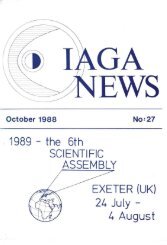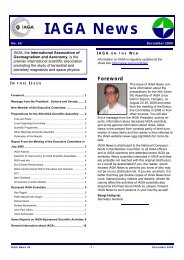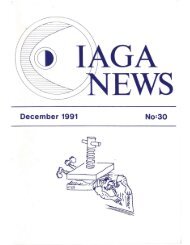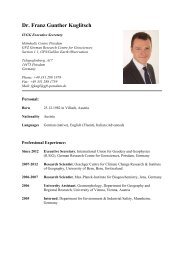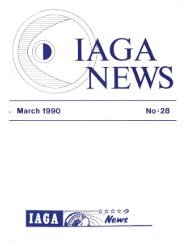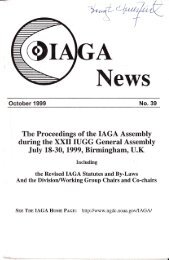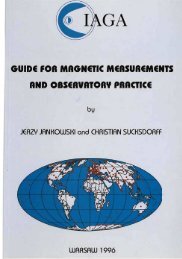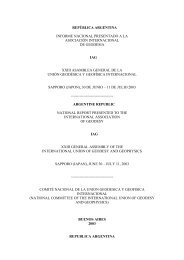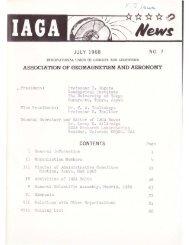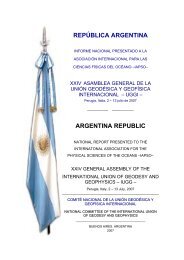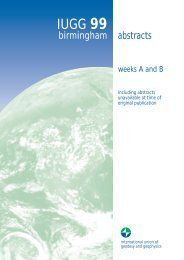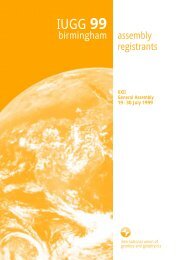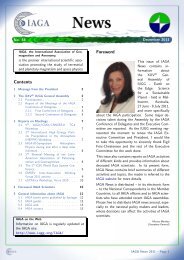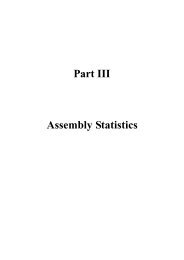xxth GENERAL ASSEMBLY OF IUGG VIENNA (AUSTRIA)
xxth GENERAL ASSEMBLY OF IUGG VIENNA (AUSTRIA)
xxth GENERAL ASSEMBLY OF IUGG VIENNA (AUSTRIA)
- TAGS
- xxth
- assembly
- iugg
- vienna
- www.iugg.org
You also want an ePaper? Increase the reach of your titles
YUMPU automatically turns print PDFs into web optimized ePapers that Google loves.
IAGA NEWS N0.29<br />
further evaluate the latitudinal influence as well as<br />
variations with solar and magnetic activity. D Anderson showed<br />
that his theoretically-derived profiles could be helpful for<br />
this purpose.<br />
Concerning the F2-peak, there exists growing interest in<br />
regional foF2 maps, in particular for the polar caps. Thiemann<br />
et al presented an interesting study using Dvinskikh's<br />
empirical orthognal functions. This subject will be considered<br />
in more detail in forthcoming group meetings. For hmF2, the<br />
group has been strongly promoting direct mapping of measured<br />
hmF2 values; up to now, predictions are obtained from global<br />
maps for the propagation factor M ( 3000) F2. With only a few<br />
incoherent scatter stations worldwide, the main data input<br />
must come from true-height analysis of ionograms.<br />
1.3 Topside ionosphere: K Rawer has shown that a better<br />
representation may be possible by using field-aligned<br />
parameters. Topside sounder data, in particular those from<br />
recent Japanese and Soviet satellites, are crucial for this<br />
task. It is hoped that these data will be made accessible to<br />
the IRI group.<br />
2 • PLASMA TEMPERATURES<br />
Seasonal trends and changes with solar and magnetic activity<br />
need further investigation, preferable with a combined data<br />
base of staellite and incoherent scatter data. K Oyama<br />
reviewed the wealth of temperature data collected by several<br />
Japanese satellites over the past two decades. This data base<br />
may lead to considerable improvements of the IRI Models.<br />
Effects of regional heating, in particular in the auroral<br />
zones, should be considered. The moving boundary of these<br />
zones presents, however, a serious problem. EISCAT and<br />
Sonderstrom data might help to assess these temperature<br />
features.<br />
3. ION COMPOSITION<br />
IRI-90 includes as a new option the Danilov-Yaichnikov model.<br />
At this meeting, first comparisons were presented between the<br />
D-Y model and a large data base of satellite ion mass<br />
spectrometer measurements compiled by W Hoegy et al. This<br />
continuing effort could result in important improvements to<br />
the IRI Model. D Bilitza introduced a promising new modelling<br />
scheme in which the transition heights play a major role. His<br />
analysis indicated, however, major discrepancies between the<br />
transition heights deduced from different models. Incoherent<br />
scatter and satellite data should be compared to resolve these<br />
differences. Further work is planned concerning the<br />
description of D-region cluster ions in IRI. The transition<br />
height from molecular to cluster ions was felt to be a<br />
critical parameter.<br />
4. ION DRIFT<br />
The preliminary IRI-90 ion drift model (written in PASCAL) is<br />
available from E Kazmirovsky. His Fourier description was<br />
established with ground-based radio observations. It was<br />
suggested that A Richmond's model, which is based on<br />
52



